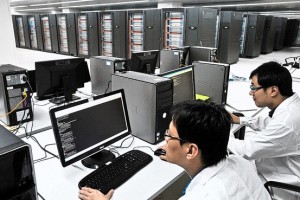 The new Tianhe-1A machine in Tianjin, China is expected to come in first in a new ranking to be released at a super computer conference this week in New Orleans. The ranking would confirm preliminary estimates that the machine scored higher on standard computing tests than the Jaguar system at Oak Ridge National Laboratory in Tennessee, which previously ranked as the world’s fastest super computer. China, which also operates the third most powerful super computer, has 42 supercomputers in the semiannual Top 500 ranking, holding a second place ranking behind the U.S. in large supercomputer installations.
The new Tianhe-1A machine in Tianjin, China is expected to come in first in a new ranking to be released at a super computer conference this week in New Orleans. The ranking would confirm preliminary estimates that the machine scored higher on standard computing tests than the Jaguar system at Oak Ridge National Laboratory in Tennessee, which previously ranked as the world’s fastest super computer. China, which also operates the third most powerful super computer, has 42 supercomputers in the semiannual Top 500 ranking, holding a second place ranking behind the U.S. in large supercomputer installations.
Tianhe-1A is one of a few machines whose capabilities exceed a “petaflop,” or a quadrillion scientific calculations per second. Chinese agencies have vowed to follow up with at least one system in five years that will reach 50 to 100 petaflops. Between 2016 and 2020 they expect to achieve one to 10 “exaflops,” or a quintillion operations per second.
It’s a long way from ENIAC, the first general-purpose, electronic computer, which handled about 5,000 calculations a second, first commissioned in 1943. Part of the ENIAC is still housed at the University of Pennsylvania where it was built. When I attended Penn in the late eighties, students could still touch the machine and fiddle with the knobs. Today, the remaining panels at Penn are protected in glass enclosed displays.
The advancement of the Chinese in the super computer realm is of course pushing the U.S. government and U.S. companies, to restore leadership in computing performance, so expect to hear more about this in the coming years.







